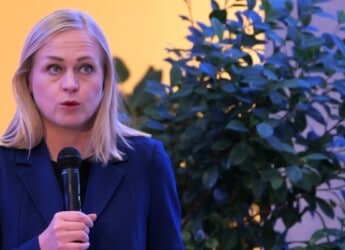|
|
Content Assessment: Perception and Reality? Ukraine Conflict Assessments in Maps (September 22 - 26, 2022)
Information - 93%
Insight - 92%
Relevance - 90%
Objectivity - 95%
Authority - 96%
93%
Excellent
A short percentage-based assessment of the qualitative benefit of the post highlighting the recent Ukraine conflict assessments in maps from the Institute for the Study of War.
Editor’s Note: One of the most accurate and detailed sources for ongoing updates on the Ukraine crisis is the Ukraine Conflict Update from the Institute for the Study of War. The Institute for the Study of War (ISW) is a 501(c)(3) organization and produces strictly non-partisan, non-ideological, fact-based research. ISW seeks to promote an informed understanding of war and military affairs through comprehensive, independent, and accessible open-source research and analysis. ISW’s research is made available to the general public, military practitioners, policymakers, and media members. Providing a daily synthesis of key events related to the Russian aggression against Ukraine, ISW updates may benefit cybersecurity, information governance, and legal discovery professionals as they follow the business, information technology, and legal trends and trajectories impacted by and stemming from the current Ukraine conflict.
Assessment and Maps*
Ukraine Conflict Assessments – An Overview in Maps
- Institute for the Study of War (ISW), Russia Team
- Critical Threats Project (CTP), American Enterprise Institute
General Assessment Background Info
- ISW systematically publishes Russian campaign assessments that include maps highlighting the assessed control of terrain in Ukraine and main Russian maneuver axes.
- These maps augment daily synthetic products that cover key events related to renewed Russian aggression against Ukraine.
The Russian Offensive Campaign Assessments
- September 26, 2022
- By Kateryna Stepanenko, Katherine Lawlor, George Barros, Riley Bailey, and Frederick W. Kagan
Key Development
- The Kremlin is attempting to message its way out of the reality of major problems in the execution of its “partial mobilization,” but its narratives are unlikely to placate Russians who can perceive the real mistakes all around them.
Key Takeaways
- The Kremlin’s planned annexation of occupied Ukraine may take place before or shortly after October 1, the start of Russia’s normal fall conscription cycle, to enable the forced conscription of Ukrainian civilians to fight against Ukraine.
- Ukrainian forces continued to make advances north of Lyman and on the eastern bank of the Oskil River.
- Ukrainian forces continued to target Russian ground lines of communication (GLOCs) as part of the southern counter-offensive interdiction campaign.
- Russian forces continued conducting offensive operations around Bakhmut and west of Donetsk City.
- Russian forces continued to use Iranian-made drones to strike Ukrainian forces and cities in southern Ukraine.
- The Kremlin may be considering formally closing its borders or more formally restricting the movement of fighting-age men within the country to better implement partial mobilization.
- Russian occupation authorities began to announce that the results of their sham annexation referenda, citing flagrantly falsified turnout numbers.
- September 25, 2022
- By Frederick W. Kagan
Key Development
- Russian President Vladimir Putin is unlikely to overcome fundamental structural challenges in attempting to mobilize large numbers of Russians to continue his war in Ukraine.
Key Takeaways
- The Russian Armed Forces have not been setting conditions for an effective large-scale mobilization since at least 2008 and have not been building the kind of reserve force needed for a snap mobilization intended to produce immediate effects on the battlefield. There are no rapid solutions to these problems.
- The problems Putin confronts stem in part from long-standing unresolved tensions in the Russian approach to generating military manpower.
- The Russian military tried to move to an all-volunteer basis amid the 2008 financial crisis and failed to make the transition fully.
- The Russian military ended up with a hybrid model blending conscript and professional soldiers.
- The reduction in the mandatory term of service for conscripts made Russia’s reserves less combat ready.
- The prioritization of building a professional force and the de-prioritization of conscript service likely translated into an erosion of the bureaucratic structures required for mobilization.
- Putin has already conducted at least four attempts at mobilization in the last year, likely draining the pool of available combat-ready (and willing) reservists ahead of the “partial mobilization.”
- September 24, 2022
- By Karolina Hird, George Barros, and Frederick W. Kagan
Key Development
- Russian Defense Minister Sergei Shoigu’s declarations about which categories of Russian males will be exempted from partial mobilization may not reflect Russian President Vladimir Putin’s intentions or orders.
Key Takeaways
- Local military commissars are carrying out mobilization orders in a way that suggests a possible disconnect between Russian Defense Minister Sergey Shoigu’s guidelines for partial mobilization and Russian President Vladimir Putin’s demands for haste.
- Russian President Vladimir Putin is likely continuing to address systemic issues in Russian senior command by replacing individual senior subordinates.
- Russia may be preparing to forcibly mobilize Ukrainian prisoners of war in what may constitute a violation of the Geneva Convention on Prisoners of War.
- Ukrainian forces likely continued to make gains along the Kharkiv-Luhansk Oblast border and northwest of Lyman.
- Ukrainian military officials indicated that the continued Ukrainian interdiction campaign in southern Ukraine is degrading Russian combat capabilities.
- Russian sources identified three locations where Ukrainian troops conducted ground operations in Kherson Oblast- northern Kherson Oblast, western Kherson Oblast near the Inhulets River, and northwest of Kherson City near the Mykolaiv-Kherson Oblast border.
- Russian forces conducted ground attacks around Bakhmut, Donetsk City, and in western Donetsk Oblast.
- Russian authorities continue to coerce residents of occupied Ukrainian territory into voting in sham referenda.
- September 23, 2022
- By Kateryna Stepanenko, Katherine Lawlor, George Barros, and Frederick W. Kagan
Key Development
- The Russian mobilization system is struggling to execute the task Russian President Vladimir Putin set and will likely fail to produce mobilized reserve forces even of the low quality that Putin’s plans would have generated unless the Kremlin can rapidly fix fundamental and systemic problems.
Key Takeaways
- Russian partial mobilization efforts are suffering from serious and systemic problems in their first days, generating popular resentment and setting conditions to produce a mobilized reserve force incapable of accomplishing the tasks Russian President Vladimir Putin has set for it.
- Protests, attacks against recruiting centers, and vandalism have occurred across Russia in the first 48 hours after the announcement of partial mobilization.
- Ukrainian forces continued to advance north and northwest of Lyman.
- Ukrainian forces continued their interdiction campaign in Kherson Oblast and maintained operational silence regarding Ukrainian progress on the axis.
- Russian forces continued to launch unsuccessful assaults near Bakhmut and northwest of Donetsk City.
- Ukrainian forces reportedly shot down an Iranian-made Mohajer-6 drone in an unspecified area of the Black Sea, likely near Odesa.
- Russian occupation authorities began the voting period for their sham annexation referenda on September 23 with overt coercion and falsified turnout numbers.
- Russian occupation authorities remained on high alert to prevent partisan attacks against sham election workers, polling stations, and government facilities.
- September 22, 2022
- By Karolina Hird, Kateryna Stepanenko, Katherine Lawlor, and Mason Clark
Key Development
- Russian forces continue to conduct meaningless offensive operations around Donetsk City and Bakhmut instead of focusing on defending against Ukrainian counteroffensives that continue to advance.
Key Takeaways
- The Kremlin’s heavy-handed approach to partial mobilization may successfully meet the Kremlin’s internal quota of mobilized personnel, but is unlikely to generate effective soldiers and is prompting significant domestic backlash for little gain.
- The Kremlin is openly not adhering to its promised conditions for partial mobilization.
- Kremlin quotas will likely force local officials to mobilize men regardless of their military status and will likely incentivize the mobilization of ethnically non-Russian and immigrant communities at a disproportionate rate.
- The Kremlin likely attempted to downplay a prisoner swap with Ukraine that is deeply unpopular among Russian nationalists and milbloggers by undertaking the swap the same day Putin announced partial mobilization.
- IAEA negotiations around the Zaporizhzhia Nuclear Power Plant are unlikely to significantly improve the situation at the plant and may provide an opportunity for Russian forces to stage provocations.
- Ukrainian forces likely continued limited counteroffensive operations along the Kharkiv-Luhansk Oblast border and continued attacks toward Lyman on September 22.
- Ukrainian military officials maintained their operational silence regarding Ukrainian ground attacks in Kherson Oblast on September 22 and reiterated that Ukrainian forces are conducting an operational-level interdiction campaign in Kherson Oblast.
- Russian forces conducted limited ground attacks along the frontlines in Donetsk Oblast on September 22.
- Russian forces did not conduct any confirmed ground attacks west of Hulyaipole on September 22 and continued routine strikes throughout western Zaporizhia Oblast.
- Russian occupation forces are hurriedly setting conditions to hold sham annexation referenda across occupied Ukraine from September 23-27.
- Russian officials created polling stations in parts of Russia, ostensibly to enable displaced (in many cases meaning kidnapped) Ukrainian residents of occupied territories to “vote.”
- Russian occupation officials in Ukraine likely expect to be forced to provide personnel to meet Russian regional mobilization quotas after the Kremlin illegally annexes occupied Ukrainian territories.
We do not report in detail on Russian war crimes because those activities are well-covered in Western media and do not directly affect the military operations we are assessing and forecasting. We will continue to evaluate and report on the effects of these criminal activities on the Ukrainian military and population and specifically on combat in Ukrainian urban areas. We utterly condemn these Russian violations of the laws of armed conflict, Geneva Conventions, and humanity even though we do not describe them in these reports.
Chronology of Maps from September 22 – 26, 2022 – Mouseover to Scroll
Ukraine Conflict Maps - 092222-092622See the Institute for the Study of War Interactive Map of the Russian Invasion
Read the latest Ukraine Conflict updates from the Institute for the Study of War
* Shared with direct express permission from the Institute for the Study of War (ISW).
About the Institute for the Study of War Research Methodology
ISW’s research methodology relies on both primary and secondary sources, enabling researchers to develop a comprehensive understanding of the situation on the ground. In order to analyze military and political developments in any given area, ISW’s research analysts must wholly understand the systems of enemy and friendly forces. They must also understand the population demographics, physical terrain, politics, and history of that area. This lays the analytical foundation for understanding the reasons for particular developments and fulfilling their assigned research objectives. ISW analysts also spend time in places like Iraq, Afghanistan, and elsewhere in order to gain a better understanding of the security and political situation and to evaluate the implementation of current strategies and policies. Our researchers compile data and analyze trends, producing a granular analysis of developments in areas of research, producing an accurate, high-resolution, timely, and thorough picture of the situation. ISW’s research methodology guarantees its success and commitment to improving the nation’s ability to execute military operations, achieve strategic objectives, and respond to emerging problems that may require the use of American military power.
About the Institute for the Study of War
The Institute for the Study of War advances an informed understanding of military affairs through reliable research, trusted analysis, and innovative education. We are committed to improving the nation’s ability to execute military operations and respond to emerging threats in order to achieve U.S. strategic objectives. ISW is a non-partisan, non-profit, public policy research organization.
Learn more, get involved, and contribute today.
Additional Reading
- [Annual Update] International Cyber Law in Practice: Interactive Toolkit
- Data Embassies: Sovereignty, Security, and Continuity for Nation-States
Source: ComplexDiscovery


























